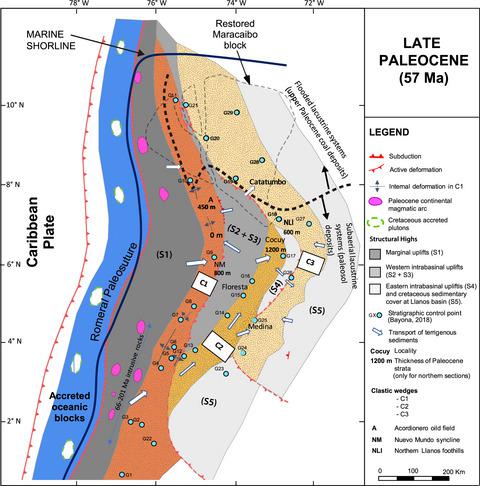当前位置:
X-MOL 学术
›
Basin Res.
›
论文详情
Our official English website, www.x-mol.net, welcomes your
feedback! (Note: you will need to create a separate account there.)
Unravelling the widening of the earliest Andean northern orogen: Maastrichtian to early Eocene intra‐basinal deformation in the northern Eastern Cordillera of Colombia
Basin Research ( IF 2.8 ) Pub Date : 2020-07-21 , DOI: 10.1111/bre.12496 Germán Bayona 1 , Mauricio Baquero 1 , Catalina Ramírez 1 , Manuela Tabares 1 , Ana M. Salazar 1 , Giovanny Nova 1 , Edward Duarte 1, 2 , Andrés Pardo 3 , Angelo Plata 3 , Carlos Jaramillo 4, 5 , Guillermo Rodríguez 6 , Victor Caballero 6 , Agustín Cardona 7 , Camilo Montes 8 , Sebastián Gómez Marulanda 4, 9 , Andrés L. Cárdenas‐Rozo 9
Basin Research ( IF 2.8 ) Pub Date : 2020-07-21 , DOI: 10.1111/bre.12496 Germán Bayona 1 , Mauricio Baquero 1 , Catalina Ramírez 1 , Manuela Tabares 1 , Ana M. Salazar 1 , Giovanny Nova 1 , Edward Duarte 1, 2 , Andrés Pardo 3 , Angelo Plata 3 , Carlos Jaramillo 4, 5 , Guillermo Rodríguez 6 , Victor Caballero 6 , Agustín Cardona 7 , Camilo Montes 8 , Sebastián Gómez Marulanda 4, 9 , Andrés L. Cárdenas‐Rozo 9
Affiliation

|
The onset of deformation in the northern Andes is overprinted by subsequent stages of basin deformation, complicating the examination of competing models illustrating potential location of earliest synorogenic basins and uplifts. To establish the width of the earliest northern Andean orogen, we carried out field mapping, palynological dating, sedimentary, stratigraphic and provenance analyses in Campanian to lower Eocene units exposed in the northern Eastern Cordillera of Colombia (Cocuy region) and compare the results with coeval succession in adjacent basins. The onset of deformation is recorded in earliest Maastrichtian time, as terrigenous detritus arrived into the basin marking the end of chemical precipitation and the onset of clastic deposition produced by the uplift of a western source area dominated by shaly Cretaceous rocks. Disconformable contacts within the upper Maastrichtian to middle Palaeocene succession document increasing supply of quartzose sandy detritus from Cretaceous quartzose rocks exposed in eastern source areas. The continued unroofing of both source areas produced a rapid shift in depositional environments from shallow marine in Maastrichtian to fluvial‐lacustrine systems during the Palaeocene‐early Eocene. Supply of immature Jurassic sandstones from nearby western uplifts, together with localized plutonic and volcanic Cretaceous rocks, caused a shift in Palaeocene sandstones composition from quartzarenites to litharenites. Supply of detrital sandy fragments, unstable heavy minerals and Cretaceous to Ordovician detrital zircons, were derived from nearby uplifted blocks and from SW fluvial systems within the synorogenic basin, instead of distal basement rocks. The presence of volcanic rock fragments and 51–59 Ma volcanic zircons constrain magmatism within the basin. The Maastrichtian–Palaeocene sequence studied here documents crustal deformation that correlates with coeval deformation farther south in Ecuador and Peru. Slab flattening of the subducting Caribbean plate produced a wider orogen (>400 km) with a continental magmatic arc and intra‐basinal deformation and magmatism.
中文翻译:

揭露最早的安第斯北部造山带的拓宽:哥伦比亚东部科尔迪勒拉北部的马斯特里赫特至始新世基底变
安第斯山脉北部的变形开始被盆地变形的后续阶段所覆盖,这使得对竞争模型的研究变得复杂,这些模型说明了最早的成因盆地和隆升的潜在位置。为了确定最早的安第斯造山带的宽度,我们在坎帕尼亚地区进行了野外测绘,孢粉测年,沉积,地层学和物源分析,以分析暴露于哥伦比亚北部东部科迪勒拉(Cocuy地区)的始新世单元,并将其结果与同期相邻盆地的演替。变形的发生是在最早的马斯特里赫特时期记录下来的,因为陆源碎屑进入盆地,标志着化学沉淀的结束和西部页岩质白垩质岩为主的隆起产生的碎屑沉积的开始。马斯特里赫特上层至古新世中期的不整合接触表明,东部源区暴露的白垩纪石英质岩石中石英质砂质碎屑的供应增加。两个源区的持续屋顶化使得沉积环境从马斯特里赫特的浅海过渡到古新世早始新世的河流湖相系统。来自附近西部隆升的未成熟侏罗纪砂岩的供应,再加上局部的深成岩和火山白垩纪岩石,导致古新世砂岩成分从石英亚砷酸盐转变为锂钙长石。奥陶纪碎屑锆石的碎屑砂石碎片,不稳定的重矿物和白垩纪的供应来自附近隆升的块体和同生盆地内西南部的河流系统。而不是远端的地下岩石。火山岩碎屑和51-59 Ma火山锆石的存在限制了盆地内的岩浆作用。此处研究的马斯特里赫特–古新世序列记录了地壳变形,该地壳变形与厄瓜多尔和秘鲁更南端的同代变形有关。俯冲的加勒比板块的平板展平产生了较大的造山带(> 400 km),具有大陆性岩浆弧以及基岩内部变形和岩浆作用。
更新日期:2020-07-21
中文翻译:

揭露最早的安第斯北部造山带的拓宽:哥伦比亚东部科尔迪勒拉北部的马斯特里赫特至始新世基底变
安第斯山脉北部的变形开始被盆地变形的后续阶段所覆盖,这使得对竞争模型的研究变得复杂,这些模型说明了最早的成因盆地和隆升的潜在位置。为了确定最早的安第斯造山带的宽度,我们在坎帕尼亚地区进行了野外测绘,孢粉测年,沉积,地层学和物源分析,以分析暴露于哥伦比亚北部东部科迪勒拉(Cocuy地区)的始新世单元,并将其结果与同期相邻盆地的演替。变形的发生是在最早的马斯特里赫特时期记录下来的,因为陆源碎屑进入盆地,标志着化学沉淀的结束和西部页岩质白垩质岩为主的隆起产生的碎屑沉积的开始。马斯特里赫特上层至古新世中期的不整合接触表明,东部源区暴露的白垩纪石英质岩石中石英质砂质碎屑的供应增加。两个源区的持续屋顶化使得沉积环境从马斯特里赫特的浅海过渡到古新世早始新世的河流湖相系统。来自附近西部隆升的未成熟侏罗纪砂岩的供应,再加上局部的深成岩和火山白垩纪岩石,导致古新世砂岩成分从石英亚砷酸盐转变为锂钙长石。奥陶纪碎屑锆石的碎屑砂石碎片,不稳定的重矿物和白垩纪的供应来自附近隆升的块体和同生盆地内西南部的河流系统。而不是远端的地下岩石。火山岩碎屑和51-59 Ma火山锆石的存在限制了盆地内的岩浆作用。此处研究的马斯特里赫特–古新世序列记录了地壳变形,该地壳变形与厄瓜多尔和秘鲁更南端的同代变形有关。俯冲的加勒比板块的平板展平产生了较大的造山带(> 400 km),具有大陆性岩浆弧以及基岩内部变形和岩浆作用。











































 京公网安备 11010802027423号
京公网安备 11010802027423号